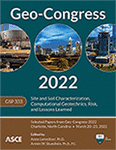Evolution of Porosity–Permeability Relationships in Bio-Mediated Processes for Ground Improvement: A Pore-Scale Computational Study
Publication: Geo-Congress 2022
ABSTRACT
Bio-mediated techniques are among biogeochemical processes in subsurface that have been introduced as alternatives to conventional methods for soil improvement. These processes can alter hydraulic properties of the subsurface through a complex veriety of coupled processes including the interaction of biomineral–biogas–biofilm with the solid matrix and pore structure of the soil. A clear understanding of these obscure interactions is critical to study the impact of bio-geochemical processes on the hydrology and predict reactive transport phenomena within the treatment zones. In this study, a 3D pore network model is extracted by CT imaging from a sandy soil sample. Various scenarios resembling different biogeochemical products and contents are numerically assigned into the networks. Simulations including evolution of pore-scale characteristics and Representative Elementary Volume (REV) scale porosity–permeability relationships are investigated. The results show that the hydraulic properties of bio-treated soils are dramatically affected by the spatial distribution, heterogeneity, and pore-habit of the products of bio-mediated processes.
Get full access to this article
View all available purchase options and get full access to this chapter.
REFERENCES
Aharonov, E., Tenthorey, E., and Scholz, C. H. (1998). “Precipitation Sealing and Diagenesis: 2. Theoretical Analysis.” Journal of Geophysical Research. Vol. 103, Issue B10: 969–992. https://doi.org/10.1029/98JB02230.
Colon, C. F., Oelkers, E. H., and Schott, J. (2004). “Experimental investigation of the effect of dissolution on sandstone permeability, porosity, and reactive surface area.” Geochimica et Cosmochimica Acta, Vol. 68, Issue 4: 805–817. https://doi.org/ 10.1016/j.gca.2003.06.002.
Cunningham, A. B., Sharp, R. R., Hiebert, R., and James, G. (2003). “Subsurface biofilm barriers for the containment and remediation of contaminated groundwater.” Bioremediation Journal, Vol. 7, Issue 3-4: 151–164. https://doi.org/10.1080/713607982.
DeJong, J. T., Martinez, B. C., Mortensen, B. M., Nelson, D. C., Waller, J. T., Weil, M. H., Ginn, T. R., Weathers, T., Barkouki, T., Fujita, Y., Redden, G., Hunt, C., Major, D., and Tanyu, B. (2009). “Upscaling of bio-mediated soil improvement.” Proc. 17th Int. Conf. Soil Mech. Geotech. Engng., Alexandria, 2300–2303. https://doi.org/10.3233/978-1-60750-031-5-2300.
Dong, H., and Blunt, M. J. (2009). “Pore-Network extraction from micro-computerized-tomography images.” Journal of Phys. Rev. E. Vol. 80, Issue 3: 06307. https://link.aps.org/doi/10.1103/PhysRevE.80.036307.
Enouy, R., Li, M., Ioannidis, M. A., and Unger, A. J. A. (2011). “Gas exsolution and flow during supersaturated water injection in porous media: II. Column experiments and continuum modeling.” Advances in Water Resources, Vol. 34, 15–25. https://doi.org/10.1016/j. advwatres.2010.09.013.
Hommel, J., Coltman, E., and Class, H. (2018).” Porosity-Permeability relations for evolving pore space: a review with a focus on (bio-)geochemically altered porous media.” Transp Porous Med. Vol. 124, 589–629.https://doi.org/10.1007/s11242-018-1086-2.
Ives, K. J., and Pienvichitr, V. (1965). “Kinetics of the filtration of dilute suspensions.” Chemical engineering Science. Vol. 20, Issue 11: 965–973. https://doi.org/10.1016/0009-2509(65)80094-X.
Le Gallo, Y., Bildstein, O., and Brosse, E. (1998). “Coupled Reaction-Flow Modeling of Diagenetic Changes in Reservoir Permeability, Porosity and Mineral Compositions.” Journal of Hydrology Vol. 209, Issue (1–4): 366–88. https://doi.org/10.1016/S0022-1694(98)00183-8.
Mahabadi, N., and Jang, J. (2014). “Relative Water and Gas Permeability for Gas Production from Hydrate-Bearing Sediments.” Geochemistry, Geophysics, Geosystems Vol. 15, Issue 6: 2346–53. https://doi.org/10.1002/2014GC005331.
Mahabadi, N., Dai, S., Seol, Y., Yun, T. S., and Jang, J. (2016). “The Water Retention Curve and Relative Permeability for Gas Production from Hydrate-Bearing Sediments: Pore-Network Model Simulation.” Geochemistry, Geophysics, Geosystems. Vol.17, Issue 8: 3099–3110. https://doi.org/10.1002/2016GC006372.
Mahabadi, N., and van Paassen, L. A. (2020). “Pore Scale Study of Gas Bubble Nucleation and Migration in Porous Media.” ArXiv Preprint ArXiv:2006.06851, June 11. http://arxiv.org/abs/2006.06851.
McCray, J. E., and Falta, J. W. (1997). “Numerical Simulation of Air Sparging for Remediation of NAPL Contamination.” Ground Water Vol. 35, Issue 1: 99–110. https://doi.org/10.1111/j.1745-6584.1997.tb00065.x.
Mostaghimi, P., Blunt, M. J., and Bijeljic, B. (2012). “Computations of absolute permeability on micro-CT images.” Math Geosci,Vol. 45: 103–125. https://doi.org/10.1007/s11004-012-9431-4.
Stallings Young, E. G., Mahabadi, N., Zapata, C. E., and van Paassen, L. A. (2021). “Microbial-induced desaturation in stratified soil conditions.” Int. J. of Geosynth and Ground Eng, Vol. 7, Issue, 37. https://doi.org/10.1007/s40891-021-00276-9.
van Paassen, L. A. (2009). “Microbes Turning Sand into Sandstone, Using Waste as Cement.” In 4th International Young Geotechnical Engineer’s Conference. Alexandria, Egypt: ISSMGE: 135–138.
Whiffin, V. S., van Paassen, V. A., and Harkes, M. P. (2007). “Microbial Carbonate Precipitation as a Soil Improvement Technique.” Geomicrobiology Journal 24 (5): 417–23. https://doi.org/10.1080/01490450701436505.
Information & Authors
Information
Published In
History
Published online: Mar 17, 2022
Authors
Metrics & Citations
Metrics
Citations
Download citation
If you have the appropriate software installed, you can download article citation data to the citation manager of your choice. Simply select your manager software from the list below and click Download.
